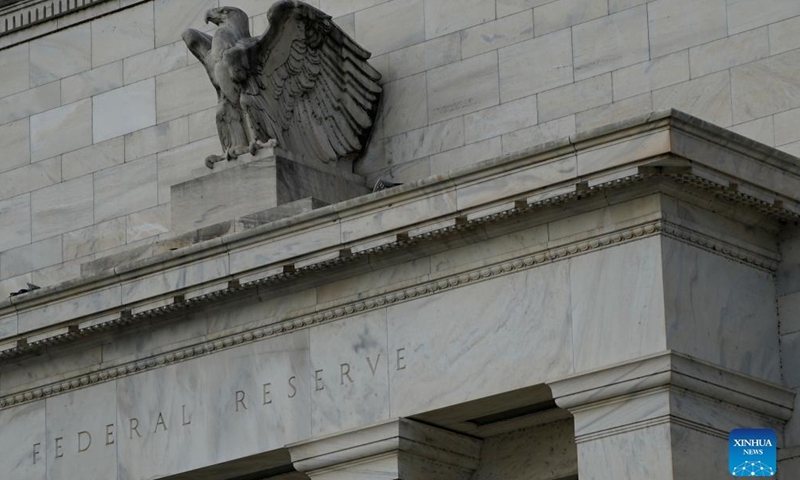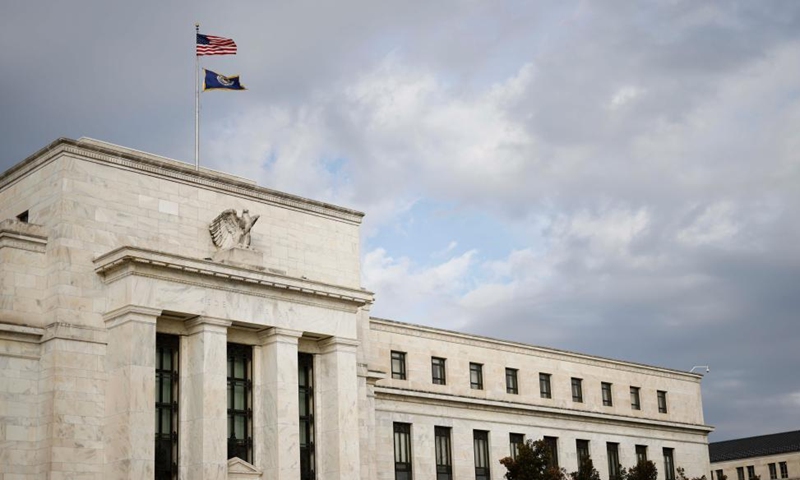
Photo taken on Jan. 25, 2022 shows the US Federal Reserve in Washington, D.C., the United States.Photo:Xinhua
The US Federal Reserve signaled on Wednesday that the central bank is ready to raise interest rates as soon as March to combat surging inflation as it exits from the ultra-loose monetary policy enacted at the start of the pandemic.
"Supply and demand imbalances related to the pandemic and the reopening of the economy have continued to contribute to elevated levels of inflation," the Fed said in a statement after a two-day meeting.
"With inflation well above 2 percent and a strong labor market, the Committee expects it will soon be appropriate to raise the target range for the federal funds rate," the Fed said, referring to the Federal Open Market Committee (FOMC), the Fed's policy-making committee.
The central bank has pledged to keep its federal funds rate unchanged at the record low level of near zero for roughly two years. But many Fed officials have expressed in recent weeks that they would be comfortable with a rate increase in March due to elevated inflation pressures.
The consumer price index rose 7 percent in December from a year earlier, the largest 12-month increase since June 1982, according to the US Labor Department.
At a virtual press conference Wednesday afternoon, Fed Chair Jerome Powell said that the US economy "no longer needs sustained high levels of monetary policy support" due to the remarkable progress in the labor market and higher inflation.
"I would say the committee is of a mind to raise the federal funds rate at the March meeting assuming that conditions are appropriate for doing so," Powell said, adding inflation risks are "still to the upside" in the views of most Fed officials.
"We will use our tools both to support the economy and a strong labor market and to prevent higher inflation from becoming higher entrenched and watching carefully to see whether the economy is evolving in line with expectations," he said.

Photo taken on Jan. 25, 2022 shows the US Federal Reserve in Washington, D.C., the United States. Photo:Xinhua
The central bank also decided to continue to reduce the monthly pace of its net asset purchases, bringing them to an end in early March.
Meanwhile, Fed officials discussed the principles for reducing the central bank's nearly 9-trillion-US-dollar balance sheet, which more than doubled during the pandemic, but they have not yet made any specific decisions.
Diane Swonk, chief economist at major accounting firm Grant Thornton, said that the FOMC made clear the intent to both raise rates and curb the size of the balance sheet in 2022.
"The vote to signal rate hikes and a reduction in the balance sheet following a liftoff in rates was unanimous," Swonk said Wednesday in an analysis, expecting the Fed to wait until June to begin reductions in its mammoth balance sheet.
"The goal will be to put the balance sheet on remote control as it shrinks. The Fed wants reductions in the balance sheet to be predictable and akin to watching paint dry," she said.
Joseph Brusuelas, chief economist at accounting and consulting firm RSM US LLP, said the Fed's post-meeting statement signals that policy normalization will soon be in full swing with a rate increase in March, which will almost surely be followed by three to four additional hikes this year.
"While there is roughly a six-month lag before rates hikes work their way into the real economy, expectations have already resulted in a de-facto tightening of financial conditions and the onset of what is likely to be two to three years of policy normalization," Brusuelas said.
Following a rate increase in March, Jay H. Bryson, chief economist at Wells Fargo Securities, expected the Fed to raise rates 25 basis points per quarter through the third quarter of 2023, bringing the federal funds rate to 1.75 percent to 2.00 percent.
"The risks seem skewed toward the FOMC moving at a faster pace and/or by more than we currently forecast if inflation remains uncomfortably high," Bryson said.
Fed officials' median interest rate projections released in December showed that the central bank could raise interest rates three times this year, up from just one rate hike projected in September, making a hawkish pivot to combat surging inflation.





